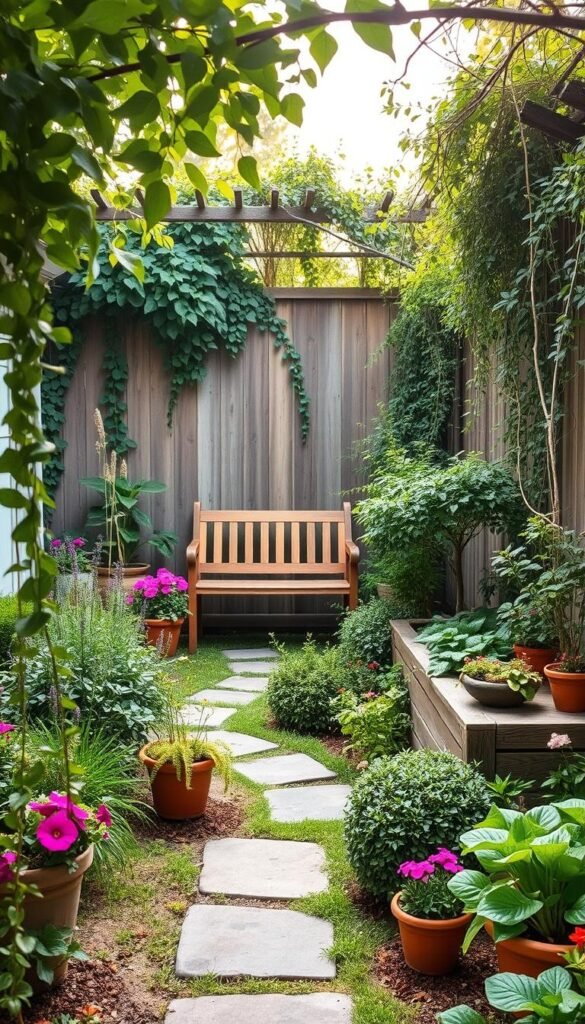Imagine stepping outside to a vibrant outdoor retreat that feels both intimate and expansive. Compact spaces are no longer obstacles—they’re invitations to reimagine what’s possible. Recent data shows over 60% of homeowners prioritize optimizing their yards, proving that creative solutions for tighter areas are in high demand.
Why do experts love crafting these cozy landscapes? It’s simple: constraints spark innovation. Designers see your petite plot as a chance to blend functionality with artistry, turning every corner into a purposeful feature. Your yard’s size isn’t a restriction—it’s the starting point for something extraordinary.
You’ll discover how layered plantings and multipurpose features create depth where space feels scarce. Vertical gardens and strategic pathways can make areas appear larger while adding practical value. Even narrow side yards transform into charming nooks with the right approach.
This guide reveals how professionals turn challenges into triumphs. Learn to view your outdoor area through a new lens, where smart material choices and scaled furnishings maximize usability. Ready to unlock your property’s hidden potential? Let’s begin reshaping your environment into a personalized oasis that punches above its weight.
Understanding Your Small Space Potential
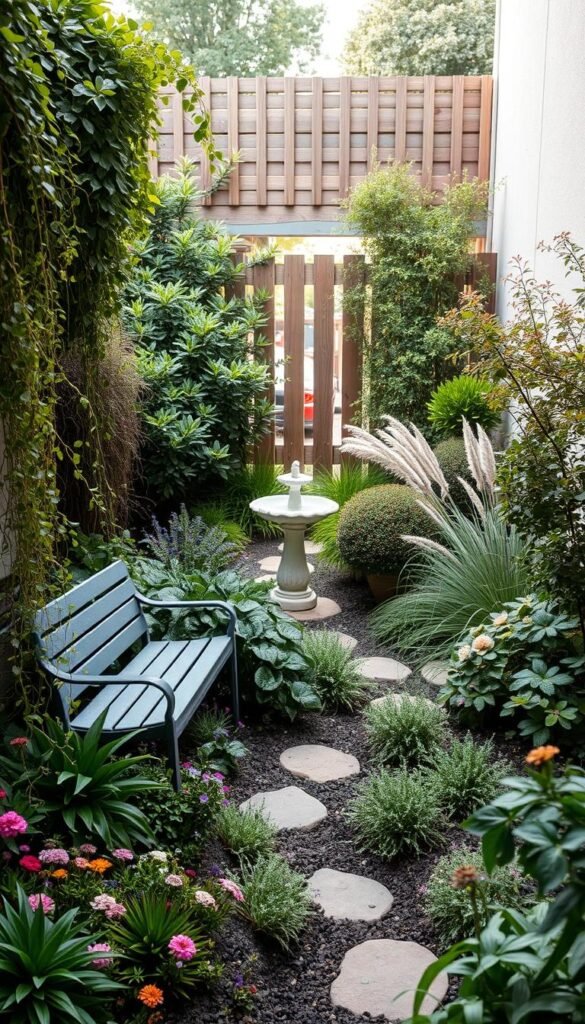
Every inch of your cozy yard can become a functional and beautiful asset. Start by observing how sunlight dances across your ground throughout the day. These patterns determine where herbs thrive or where shade-loving ferns belong.
Assessing What You Already Have
Walk through your space like a detective. Note uneven surfaces that could trip guests or perfect corners for a reading nook. Designers often spot hidden gems – that old stone wall might become a succulent display feature.
| Feature | Challenge | Opportunity |
|---|---|---|
| Narrow walkway | Restricts movement | Perfect for vertical planters |
| Shady corner | Limited plant options | Ideal for moss garden |
| Sloped area | Erosion risk | Natural terraced planting beds |
Spotting Growth Possibilities
Look upward! Blank fences become living walls with climbing roses. Notice how doors connect indoor and outdoor areas – maybe your kitchen window needs herb boxes. Even awkward angles can house a petite water feature.
Your yard’s unique character emerges when you work with its natural flow. Professionals suggest mapping foot traffic for a week – you’ll discover paths begging for stepping stones. Remember, constraints often birth the most creative landscaping solutions.
Prioritize Your Backyard Must-Haves
Your outdoor area becomes an extension of your home when every element serves a purpose. Start by grabbing a notebook and listing every feature your family dreams about – from fire pits to flower beds. This exercise reveals what truly matters for your daily life versus temporary whims.
Ranking Your Family’s Outdoor Needs
Ask each household member: “What three things would make this living space perfect?” Compare answers. A dining zone might beat that cocktail bar if Tuesday taco nights are sacred. Creative solutions emerge when you align wishes with reality – maybe that grill station doubles as a buffet counter during gatherings.
Consider seasonal shifts too. A summer splash pad could transform into autumn’s leaf-pile paradise. Leave breathing room between features – literal space to grow prevents that cramped feeling. Experts suggest reserving 20% of your layout for future adjustments as kids age or hobbies change.
Balance visual appeal with practicality. That zen rock garden might soothe your soul, but will it host Saturday soccer matches? For gardening aesthetic inspiration that serves multiple needs, try vertical herb walls near seating areas – beauty meets functionality.
Small Backyard Garden Design: Making the Most of Limited Square Footage
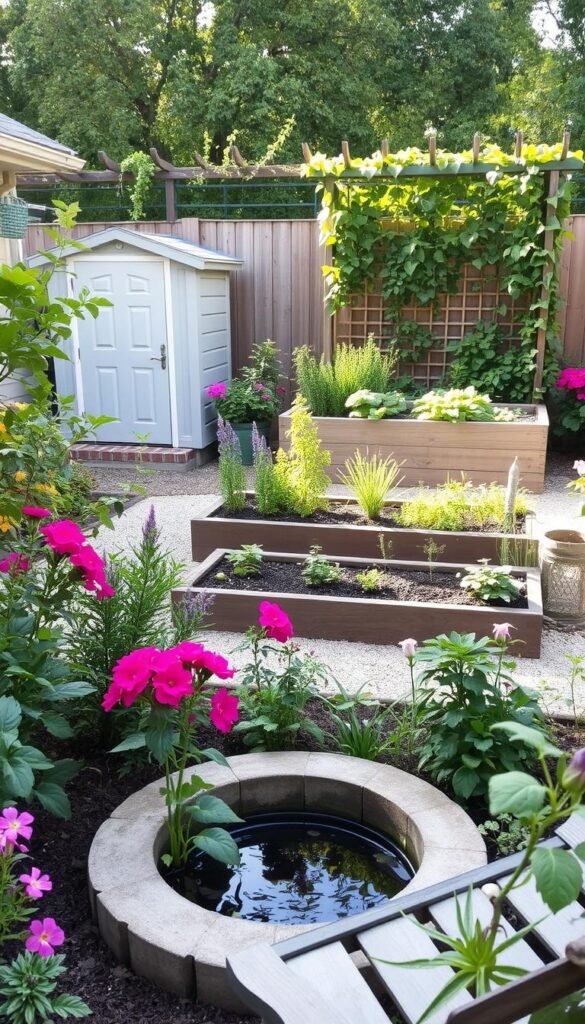
Transforming your outdoor area doesn’t require emptying your wallet—it demands smart resource allocation. Costs for refreshing your space can start under $500 for basic upgrades or climb above $10,000 for luxury additions. The secret? Balancing immediate visual wins with long-term investments that grow with your lifestyle.
High-impact, low-cost strategies deliver instant gratification. Think colorful perennials clustered near seating areas or mulch that defines walking paths while suppressing weeds. Even swapping out old pavers for gravel creates texture without breaking the bank.
- Seasonal blooms: $3–$15 per plant
- Mulch installation: $200–$600
- DIY stepping stones: $1–$5 per square foot
When eyeing pricier elements like pergolas or irrigation systems, phase them over multiple seasons. A professional plan ensures each addition complements the next—no wasted effort. “Start with what you’ll use daily, then build outward,” advises landscape architect Mara Klein.
Smart allocation means prioritizing durability where it counts. Weather-resistant furniture lasts longer than cheap alternatives, while proper drainage prevents costly repairs. By mixing affordable greenery with strategic splurges, you craft a space that feels lavish yet lived-in.
Creating a Functional Layout and Blending Indoor-Outdoor Living
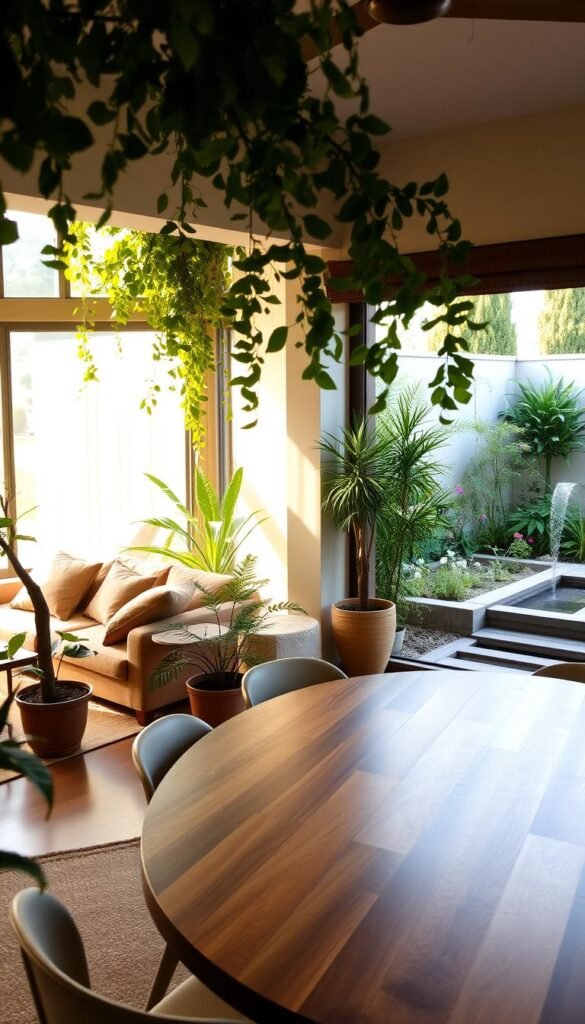
Movement defines how you experience your environment. A well-planned arrangement turns cramped zones into inviting living areas that feel intuitive to navigate. Start by sketching how people move from your home to the patio—these natural pathways become your blueprint.
Establishing Clear Traffic Flow
Wide, curved walkways prevent bottlenecks better than straight lines. Use materials matching your interior floors to trick the eye into perceiving more space. Designers often lay stepping stones 24 inches apart for comfortable strides.
| Path Material | Pros | Cons | Best For |
|---|---|---|---|
| Gravel | Quick installation | Needs edging | Casual pathways |
| Pavers | Durable surface | Higher cost | Main routes |
| Mulch | Soft texture | Annual refresh | Garden edges |
Incorporating French Doors and Large Windows
Glass panels dissolve barriers between inside and outside. One homeowner doubled their entertaining areas by replacing a solid door with folding panes. “Suddenly, our kitchen became part of the patio,” they noted.
Position potted plants near thresholds to soften transitions. Matching indoor and outdoor cushions on seating creates visual harmony. For homes without renovation budgets, sheer curtains near windows mimic the airy effect of open doors.
“Aligning floor levels between rooms and decks makes spaces feel continuous—like your living room just grew a new wing.”
Creative Ways to Utilize Vertical Space
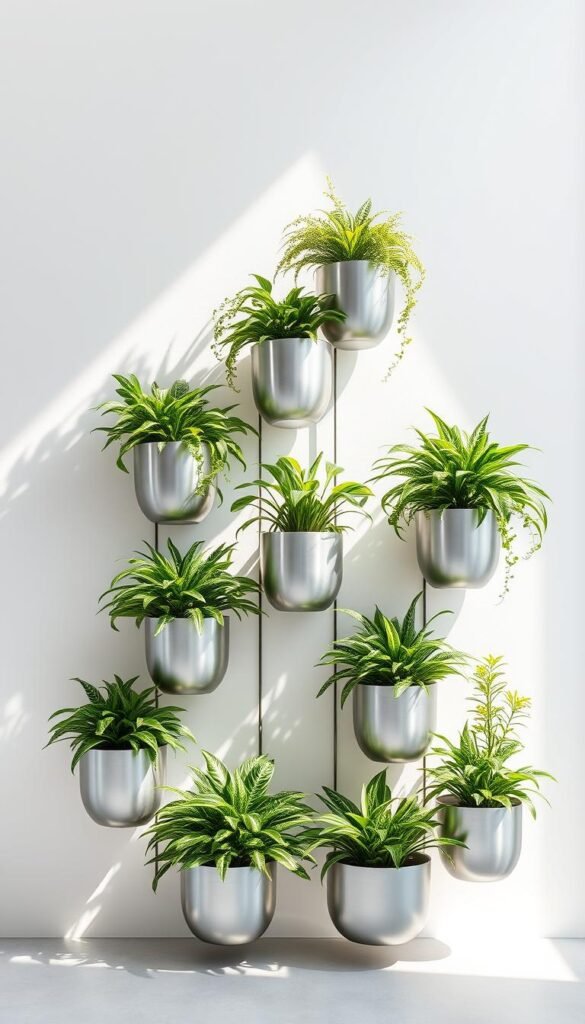
Elevate your outdoor experience by thinking upward, not outward. Vertical surfaces become prime real estate when ground space feels scarce. With 78% of urban gardeners reporting success with elevated growing systems, this approach lets you multiply your planting zones without expanding your footprint.
Vertical Gardening and Hanging Planters
Hanging baskets instantly add life to overlooked areas. Try trailing petunias near seating spots or herbs above grill stations. Wall-mounted planters with drip irrigation turn blank surfaces into edible displays. One homeowner grew 15 varieties of salad greens in a 4-foot-wide system!
| System | Benefits | Best Plants |
|---|---|---|
| Pocket planters | Easy to rearrange | Strawberries, succulents |
| Rail planters | Maximize balcony space | Basil, pansies |
| Tiered stands | Create depth | Fern varieties, begonias |
Multi-tiered Planters and Green Walls
Stacked containers let you grow tomatoes above marigolds, saving room while pairing companions. DIY green walls transform fences into living art—use modular panels with drought-tolerant sedum for low maintenance. Climbing roses or clematis add vertical drama when trained on trellises.
Choose plants wisely for elevated success. Compact cherry tomatoes thrive in hanging baskets, while ivy creates quick privacy screens. Remember: lightweight soil mixes prevent structural strain. As landscape designer Elena Carter advises, “Build your vertical layers like a shelf—put sun-lovers up top, shade-tolerant below.”
Smart Hardscape and Lighting Ideas
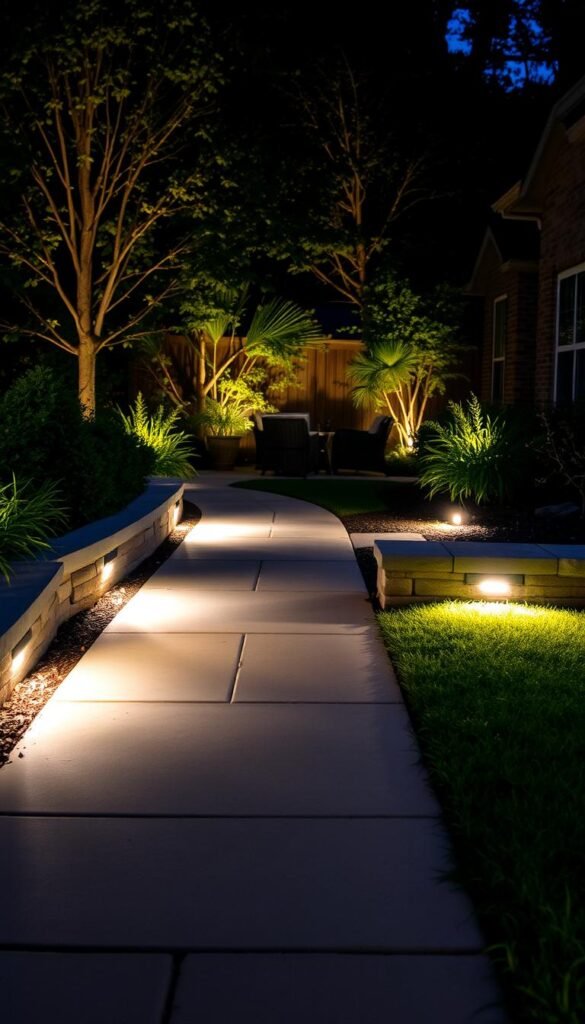
Your outdoor oasis deserves a foundation that shines day and night. Clever material combinations and layered illumination turn functional elements into design stars. The right balance creates rhythm in cozy areas while expanding perceived space.
Choosing the Right Materials for Paving
Mix textures to guide the eye without clutter. Extend a patio with pea gravel borders for contrast that costs less than full stonework. Decomposed granite offers similar benefits—its loose form softens hard lines while allowing drainage.
| Material | Best Use | Maintenance |
|---|---|---|
| Concrete pavers | Dining zones | Low |
| Flagstone | Curved pathways | Moderate |
| Gravel | Casual walkways | Annual topping |
Narrow spaces benefit from elongated patterns. Run pavers diagonally to create width illusions. “Horizontal lines stretch tight areas, while vertical accents add height,” notes landscape pro Tyler Morrow.
Using Landscape Lighting to Enhance Ambiance
Layer three light types for depth: uplights on trees (ambient), step lights (task), and string bulbs overhead (accent). Solar stakes along paths offer eco-friendly glow without wiring hassles. For common pitfalls, avoid blinding spotlights—soft diffusion works better.
Highlight textural walls or specimen plants with adjustable LEDs. Timer systems keep your patio inviting after sunset. Pro tip: Warm white bulbs (2700K-3000K) feel cozier than harsh daylight tones.
Multipurpose Outdoor Furnishings and Storage Solutions
Your outdoor area transforms when every piece pulls double duty. Furniture that serves multiple roles maximizes enjoyment without crowding your environment. Start by reimagining how each item can solve two problems at once.
Built-in Seating Areas and Dual-Purpose Furniture
Foldable chairs tuck under wall-mounted tables when not in use, freeing up walking paths. A bench with hidden compartments stores cushions while providing seating for six. One homeowner replaced their bulky dining set with a nesting table system that expands for parties.
Consider a gas fire pit that moonlights as a coffee table – perfect for marshmallow nights or morning lattes. Ottomans with lift-up lids offer instant storage for throws and gardening tools. For creative gardening ideas, try planter boxes that double as privacy screens between lounge chairs.
Built-in designs create seamless functionality. Stone benches along retaining walls add permanent seating without floor space. Corner banquettes with weather-resistant cushions make awkward areas social hotspots. As designer Lori Weitzner notes: “Multitasking pieces let your environment adapt faster than your plans change.”
Budget-Friendly and Sustainable Design Options
Smart choices today can save money and resources tomorrow. Focus on solutions that nurture your environment while respecting your wallet. Sustainability isn’t just trendy—it’s practical for creating thriving spaces that age gracefully.
Implementing Xeriscaping and Native Plants
Swap thirsty lawns for drought-tolerant plants that bloom season after season. Native species like coneflowers or sagebrush thrive with minimal water, cutting irrigation needs by up to 60%. Gravel pathways cost less than pavers while letting rainwater recharge the soil beneath.
Group gardens by water needs for efficient care. A permaculture-inspired approach uses fallen branches for trellises and kitchen scraps for compost. This reduces waste and fertilizer costs naturally.
Mulch does triple duty—locking in moisture, suppressing weeds, and enriching soil as it breaks down. Pair it with artificial turf in play zones for year-round greenery without mowing. Repeating colors across planters creates cohesion, making compact areas feel intentional rather than cramped.
Rain barrels collect free water for your hydrangeas, while clustered native shrubs shelter local birds. Every eco-conscious choice builds a habitat that gives back. Your space becomes a living example of how landscaping can harmonize beauty with responsibility.

